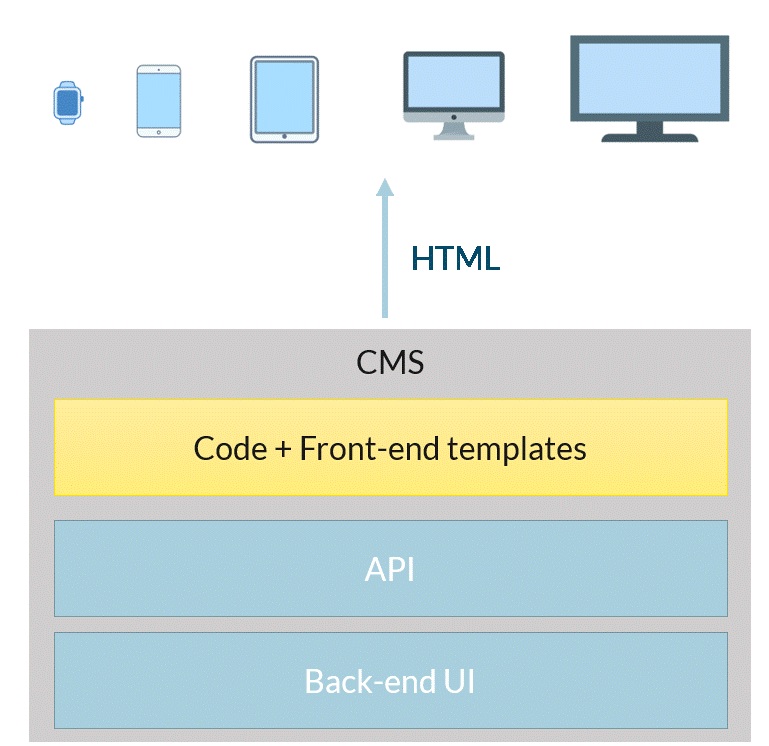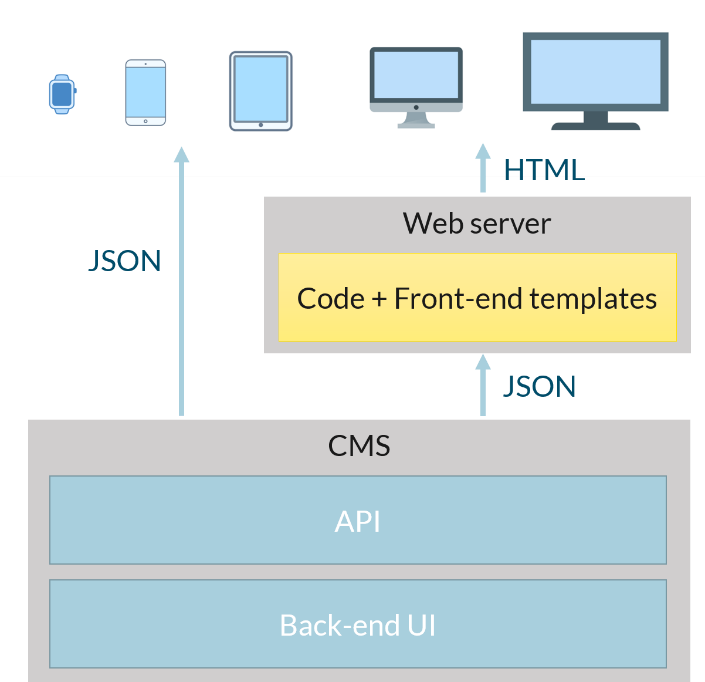The term 'Headless CMS' has been popping up more and more lately. Market leaders Kentico and Sitecore have also announced headless versions of their products. We'll explain what Headless is and why we're so excited about it at Aviva Solutions.
With a Headless CMS, the focus is solely on the content itself, not on its presentation, as with a traditional CMS. The presentation is decoupled from the content. The content is accessed via an API (application programming interface) and can thus be used by various media.
Figure 1 shows that a traditional CMS consists of a UI (user interface) to manage the content, (internal) APIs to retrieve the content, and finally, code and templates to present the content. The presentation takes place in HTML, which stands for Hypertext Markup Language. HTML is the standard markup language for displaying a web page in browsers.

Figure 1: a traditional CMS, consisting of a User Interface, API connections, and Code templates.
A Headless CMS (Figure 2) offers only a UI to manage the content and an API to access the data. The data is provided in JSON format. JSON stands for JavaScript Object Notation and is currently the standard for structured data provisioning. With a headless CMS, a separate website, the web server, is required to convert the JSON data to HTML so a browser can display the content.

Figure 2: A Headless CMS, that consists of a User Interface and API connections. It disconnects the Code templates.
Below we summarize six of the key benefits of a headless CMS.
With a traditional CMS, content is linked to the presentation. This can lead to each channel having its own version of the content, for example, on the website, in mobile apps, and in advertisements. If the content contains an error, you have to fix it separately for each channel. This is much more efficient with a Headless CMS. Because the content is not linked to the presentation, you only need one version for all channels. So you only have to manage the content in a single location.
A second advantage: developers know more quickly whether a change has the intended effect because they don't have to restart the CMS for every change. There's also a more explicit separation between the front-end and back-end interfaces. This clarifies responsibilities and contributes to more effective communication between front-end and back-end developers.
Another advantage we often hear is that developing the front-end and implementing the content can take place simultaneously. That's true, but coordination between the content structure and the design implementation is also necessary. In our experience, the ultimate time savings are negligible.
Typically, the CMS dictates the website's technology. Since content and presentation are decoupled, headless developers can choose the technology themselves. This allows them to opt for the best of breed instead of an All-In-One solution. For example, if extensive search functionality or personalization isn't required at the start of the project, you can start with a simple CMS. These services can then be added later on.
Upgrading the CMS is easier because less development is done on top of the CMS itself. This means you don't have to worry as much about whether connections and features will continue to function properly during an upgrade. A logical next step is Software as a Service (SaaS), which eliminates the need to manage a content management environment entirely.
Because presentation and content are decoupled and the choice of technology isn't limited by the CMS, it's much easier to add a new, innovative application, such as a virtual reality app. Upgrading the front-end to the latest technology is also less work.
Because a Headless CMS doesn't handle the presentation itself, the process requires less processing power than a traditional CMS. This allows you to host the website on multiple servers much more efficiently and cost-effectively.
Yes, using a Headless CMS also has its drawbacks. Or rather: challenges. The four most important ones are listed below.
A traditional CMS supports the developer in setting up the website. With a Headless CMS, you have to outsource these facilities or, as a developer, find the necessary libraries yourself. This means writing more code.
A Headless CMS is only responsible for the content and knows nothing about the presentation. This means you can't edit the content directly in the design and immediately see how it will appear on the website. So there's no WYSIWYG, no "what you see is what you get". It's often possible to open a preview of the website in a separate browser window. This way, you can still see how the content will appear on the website. However, it's important to know which content appears where.
A traditional CMS these days comes with extensive analytics and personalization options. With a Headless CMS, analytics and especially personalization require significant front-end programming.
The architecture of a Headless CMS allows you to choose best-of-breed instead of an All-In-One solution. This can lead to a situation where you use a large number of services, requiring expertise across them. Moreover, integration between services quickly adds complexity. Each service also has its own costs, making it harder to clearly understand the total monthly cost.
We've personally experienced the incredible freedom and flexibility a Headless CMS offers. The drawbacks of a Headless CMS are less significant for us. Design and front-end development play a significant role in the projects we handle at Aviva Solutions. Our clients value their online identity, which means a significant amount of customization is required in the front-end code, even without a Headless CMS.
The advantages of Headless are actually enormous. In our projects, the enormous amount of time spent on peripherals like upgrades and the complexity of the environment are among the biggest drawbacks of a traditional CMS. With a Headless CMS, it makes sense to opt for a SaaS solution, which eliminates this problem.
However, Headless isn't the right choice for every project. For projects with a strong focus on content and less emphasis on presentation, a traditional CMS is preferable, especially because of the shorter time to market. Do pay attention to whether there are plans for omnichannel, as this is easier to achieve with a Headless CMS. Considering a new CMS and feeling overwhelmed? Then read our article with five tips for making the right CMS choice.
MACH is a modern, modular approach that prioritizes flexibility, scalability, and agility. But how does it work?
Continue readingThe smallest changes have massive impact.
Continue readingWant to stay informed about everything happening with Composable Commerce? Sign up for our updates here!
We've built converting e-commerce platforms for our customers for more than 15 years.
You don't just pick a new e-commerce platform. Especially with the sheer volume of available vendors and services. What's the best course of action? Together we will determinate the technical solution that best fits your business goals. Do you want to know how we approach e-commerce projects? We'd love to start a conversation!
Get the right insights!E-Commerce Solutions Specialist
Digital Experience Expert